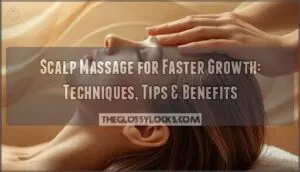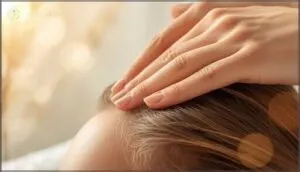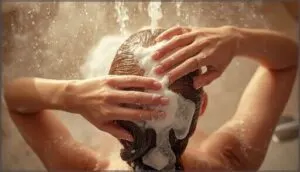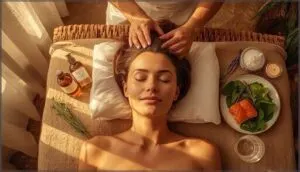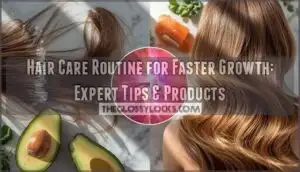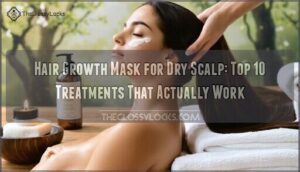This site is supported by our readers. We may earn a commission, at no cost to you, if you purchase through links.
Your hair follicles sit beneath your scalp, waiting for signals that tell them to grow—and one of those signals comes from something as simple as touch. When you massage your scalp, you’re not just enjoying a relaxing moment; you’re actually increasing blood flow by up to 120%, delivering oxygen and nutrients directly to the roots where hair growth begins. This mechanical pressure wakes up dormant follicles and triggers cellular responses that thicken existing strands.
The connection between scalp massage for faster growth and measurable results isn’t just folklore—clinical trials document strand diameter increases after consistent practice. Beyond the physical benefits, reducing stress through regular massage lowers cortisol levels that otherwise disrupt the hair growth cycle.
Learning the right techniques, timing, and tools transforms this simple practice into a powerful addition to your hair care routine.
Table Of Contents
- Key Takeaways
- How Scalp Massage Promotes Hair Growth
- Effective Scalp Massage Techniques
- Using Tools and Essential Oils for Massage
- Additional Benefits of Scalp Massage
- Tips for Faster Hair Growth Results
- Frequently Asked Questions (FAQs)
- Does a scalp massage increase hair growth?
- How does a scalp massage work?
- Is a scalp massage good for your hair?
- Can a scalp massage make hair thicker?
- Can a scalp massage cure hair loss?
- Can a scalp massage improve your hair texture?
- Can scalp massage reverse baldness or hair loss?
- How long until visible hair growth results appear?
- Are there side effects from daily scalp massage?
- Does scalp massage work for all hair types?
- Conclusion
Key Takeaways
- Scalp massage increases blood flow to hair follicles by up to 120%, delivering oxygen and nutrients that activate dormant follicles and can increase hair strand diameter from 0.085 mm to 0.092 mm after 24 weeks of consistent practice.
- The mechanical pressure from massage triggers cellular changes in dermal papilla cells and upregulates growth-promoting genes like NOGGIN and BMP4, while simultaneously reducing cortisol levels that disrupt the hair growth cycle.
- Effective techniques include traditional fingertip massage for 4-10 minutes daily, incorporating massage during shampooing, and using diluted essential oils like rosemary or peppermint with carrier oils to enhance follicle stimulation.
- Results typically appear within 2-3 months of regular practice (3-5 sessions per week), but massage works best when combined with proper nutrition including adequate protein (46-56 grams daily), vitamin D, iron, and omega-3 fatty acids.
How Scalp Massage Promotes Hair Growth
Scalp massage works by targeting the hair follicles themselves, creating conditions that support healthier, stronger growth. The process involves more than just relaxation—it triggers physical and biological changes in your scalp that directly affect how your hair develops.
Here’s what happens beneath the surface when you massage your scalp regularly.
Blood Flow and Follicle Stimulation
Your scalp’s circulation increases by up to 120% during massage, sending oxygen and nutrients straight to your hair follicles. This boost in blood flow activates dormant follicles and aids the anagen growth phase. The mechanical pressure creates dermal displacement, which stimulates dermal papilla cells and increases vascularization effects around each follicle.
Scalp massage increases circulation by up to 120%, delivering oxygen and nutrients that activate dormant follicles and stimulate growth
Enhanced nutrient delivery strengthens follicle activation, promoting thicker, healthier hair. Regular massage also stimulates hair regeneration.
Stress Reduction and Hair Health
When you’re stressed, cortisol floods your system and disrupts hair follicle function, triggering stress-related alopecia in many cases. Massage for calm works by lowering these stress hormones, with sessions reducing cortisol levels considerably. This hormonal impact matters because 73.8% of hair loss cases link directly to stress.
Your mental well-being improves through relaxation and stress relief, while better blood circulation promotes overall hair health naturally. Regular scalp massage can also balance scalp oil.
Scientific Evidence and Study Highlights
Research backs up what stress reduction suggests. Clinical trials show a thickness increase from 0.085 mm to 0.092 mm after 24 weeks of daily massage, though hair count sometimes decreases.
Gene expression changes in hair follicles reveal upregulated growth-promoting genes like NOGGIN and BMP4. This scientific evidence of hair growth stimulation confirms massage affects follicle health mechanically, yet future research needs larger studies for definitive conclusions.
Effective Scalp Massage Techniques
You don’t need fancy equipment or a professional to get the benefits of scalp massage. The right technique matters more than how much you spend.
Here are three methods you can start using today to stimulate your hair follicles and encourage growth.
Traditional Fingertip Massage
You don’t need fancy gadgets to get started. Traditional scalp massage with your fingertips involves applying gentle, circular pressure across your entire scalp for about 4 to 10 minutes daily. Use the pads of your fingers, not your nails, and adjust pressure based on your scalp’s sensitivity.
Dry massage benefits oily scalps, while adding oil helps reduce friction on drier skin.
Massage While Washing Hair
When you’re already in the shower, you can combine your regular hair care routine with scalp massage techniques. While shampooing or applying conditioner, use your fingertips to work the product in with gentle, circular motions for about 5 minutes.
This approach enhances tissue displacement, boosts scalp hygiene by removing buildup, and improves blood flow. The stress reduction from this simple addition fosters healthier hair growth.
Myofascial Release for The Scalp
Beyond basic circular motions, myofascial release targets fascia restrictions with sustained, gentle pressure to improve blood circulation. This massage technique may boost the follicle environment by reducing tissue tension and supporting nutrient delivery.
- Multiple sessions weekly over several weeks show maximum headache relief
- Studies report increased hair thickness after 24 weeks
- Clinical limitations include small sample sizes and unclear biochemical mechanisms
Using Tools and Essential Oils for Massage
You don’t need to rely solely on your hands to massage your scalp effectively. Specialized brushes and handheld devices can make the process easier, while essential oils may offer additional benefits for hair growth.
Let’s explore how to choose and use these tools safely to get the most out of your scalp massage routine.
Scalp Massaging Brushes and Devices
If you want to take your scalp massage routine beyond fingertips, scalp massaging tools offer an efficient alternative. These devices come in various mechanical designs, from handheld brushes with soft silicone bristles to electric features like vibrating heads and adjustable intensity settings. Consumer preferences lean toward tools that boost blood flow and relaxation during shampooing. While about 14.6% of users report noticeable stimulation, safety practices matter—avoid excessive pressure and clean brush heads regularly to prevent irritation.
| Device Type | Key Features | Best For |
|---|---|---|
| Silicone Brush | Flexible bristles, manual control | Gentle daily use |
| Electric Massager | Vibration, heat therapy options | Deep stimulation |
| Helmet Device | Full-scalp coverage, multiple motors | Extensive treatment |
Applying Essential Oils for Growth
Essential oils can boost your scalp massage routine, but proper application makes all the difference. Dilute oils like peppermint oil or rosemary oil with carrier oils—usually 5-10 drops per 3 tablespoons. This prevents irritation while allowing scalp absorption.
Massage the mixture gently into your scalp, focusing on areas with thinning hair. Oil combinations improve benefits, so experiment with blends that target your specific hair growth goals.
Safety Tips for Oils and Tools
Even a beneficial practice like scalp massage carries risks if you’re not careful. Protect your scalp and hair by following these safety measures with oils and massage devices.
- Test for oil allergies: Apply diluted essential oils to your inner arm first, since 8-20% of people experience contact dermatitis from fragrance compounds in aromatherapy products.
- Clean your massage device weekly: Bacteria and fungi thrive on unwashed tools, potentially causing scalp infections.
- Use gentle pressure: Aggressive use can break fragile hairs and worsen thinning, especially with weakened follicles.
Always dilute essential oils with carrier oils—1-2 drops per tablespoon prevents irritation while maintaining effectiveness. If you have scalp sensitivity, psoriasis, or eczema, consult a healthcare professional before starting. Pregnant women and children need medical guidance too, as certain oils pose contraindications.
When you respect dilution guidelines and maintain tool hygiene, scalp massage remains safe and effective for promoting hair growth.
Additional Benefits of Scalp Massage
While hair growth often gets the most attention, scalp massage offers benefits that go beyond just lengthening your locks.
You might notice improvements in how your hair looks and feels, plus some unexpected perks for your overall comfort. Here’s what else regular scalp massage can do for you.
Improving Hair Thickness and Texture
If you’re looking to improve hair texture and boost thickness, regular scalp massage works from the inside out. It increases follicle diameter, meaning thicker strands that feel fuller. Studies show individual hair shaft thickness can jump from 0.085 mm to 0.092 mm with daily massage.
You’ll notice improved scalp hydration, better keratin production, and enhanced hair resilience, leading to stronger, more manageable hair overall.
Relief From Tension Headaches
Beyond thicker hair, scalp massage offers tension relief that targets common headache triggers. Massage therapy improves circulation while releasing tight muscles around your temples and neck, reducing stress hormones by up to 30%. You’re addressing both stress management and migraine prevention when you practice these massage techniques regularly.
- Decreases headache frequency from 6.8 to 2.0 per week
- Reduces tension headaches through targeted pressure points
- Lowers cortisol levels within 15-25 minutes
- Provides stress reduction lasting up to 72 hours
Balancing Scalp Oil Production
Scalp massage improves scalp health by redistributing natural oils and regulating sebum production factors through enhanced circulation. Your stress reduction from regular massage helps stabilize hormone-related oil fluctuations, while gentle massage oil distribution prevents buildup that contributes to dandruff.
Studies show washing 5-6 times weekly optimizes oil balance, and targeted ingredients like zinc PCA and salicylic acid address excess sebum when needed for healthier follicles.
Tips for Faster Hair Growth Results
While scalp massage can stimulate follicles and improve circulation, it works best when you support your hair from multiple angles. Consistency matters, but so do the habits you maintain between massage sessions.
Here’s how to get the most from your results and avoid setbacks that slow down progress.
Recommended Massage Frequency
Generally, you’ll want to massage your scalp 3–5 times per week for consistent practice, with each session lasting 5–10 minutes. Daily massage can work well if you’re not using oils, but if you’re, limit application to avoid buildup.
Those with sensitivity considerations may prefer weekly sessions to prevent irritation.
Studies show that regular scalp massage benefits appear after several months of commitment.
Supporting Hair Health With Nutrition
Your diet directly impacts hair follicle health. Protein intake—aim for 46–56 grams daily—supplies keratin-building amino acids. Vitamin deficiencies, especially vitamin D, correlate with increased hair loss. Iron levels below 30–40 ng/dL affect 32–50% of women with thinning hair.
Omega-3s from fatty fish reduce scalp inflammation, while antioxidant foods like cruciferous vegetables combat oxidative stress. Addressing nutritional deficiencies strengthens your hair care routine from the inside out.
Avoiding Common Hair Care Mistakes
Even with regular scalp massage, certain hair care mistakes can undermine hair growth. Overwashing effects include stripping natural oils, while skipping washes allows buildup that accelerates hair loss.
Heat protection prevents the 60% spike in breakage from styling tools. Conditioner overuse clogs follicles—apply only to ends.
Chemical damage from frequent dyes weakens strands by 45%. Never brush wet hair; it increases breakage by 70%.
Frequently Asked Questions (FAQs)
Does a scalp massage increase hair growth?
Can something so simple really work? Yes, scalp massage does increase hair growth by stimulating follicles and boosting blood flow, though study limitations mean results vary widely depending on technique comparison and consistency.
How does a scalp massage work?
When you massage your scalp, blood flow increases to the hair follicles, delivering nutrients and oxygen.
The pressure also triggers cellular changes in the dermal papilla, altering gene expression that aids hair growth.
Is a scalp massage good for your hair?
Yes, scalp massage benefits hair health by improving blood circulation to follicles, reducing stress that contributes to hair loss, and enhancing hair thickness.
Regular massage aids scalp health and promotes stronger hair quality.
Can a scalp massage make hair thicker?
Regular scalp massage can increase hair thickness by stimulating hair follicle health through improved blood flow and cellular stretching.
Studies show daily four-minute sessions improve hair diameter over 24 weeks, demonstrating effective thickening techniques.
Can a scalp massage cure hair loss?
While scalp massage can help stabilize hair loss and improve thickness in some people, it won’t cure pattern baldness or other medical causes. Think of it as a supportive tool, not a miracle fix.
Can a scalp massage improve your hair texture?
Your hair texture can improve through consistent massage. Mechanical stimulation distributes sebum production evenly, enhancing hair texture and shine.
Exfoliation benefits include removing buildup, while oil distribution promotes hair manageability, thickness, and overall hair health.
Can scalp massage reverse baldness or hair loss?
While massage won’t reverse established baldness patterns, clinical trials show 69% of participants experienced hair loss stabilization or modest regrowth.
Success depends on massage dosage, population response, and consistent follicle stimulation over months.
How long until visible hair growth results appear?
You’ll generally notice improvements within two to three months of consistent practice. Hair thickness increases may appear sooner, while new regrowth becomes visible around the 12-week mark with regular follicle stimulation.
Are there side effects from daily scalp massage?
While generally safe, overdoing it can lead to skin irritation, scalp sensitivity, or follicle damage. Aggressive techniques may worsen oil imbalance and increase infection risk, especially with unsanitized tools or pre-existing skin inflammation.
Does scalp massage work for all hair types?
Yes, it works for all hair types. Blood flow increases and follicle stimulation occur universally, though curly or coily hair may need gentler pressure and massage oil benefits to prevent scalp sensitivity risks while supporting hair growth.
Conclusion
You might think hair growth depends entirely on genetics or expensive products, but your own hands hold surprising power. Consistent scalp massage for faster growth delivers measurable results by boosting circulation, reducing stress hormones, and waking up dormant follicles.
Pair these techniques with proper nutrition and gentle care, and you’ll create the ideal environment for thicker, healthier strands. The science backs what your scalp already knows: simple, deliberate touch makes a real difference.
- https://www.researchgate.net/publication/343299641_Effects_of_Reflexology_Massage_on_Hair_Regrowth_After_Chemotherapy-induced_Alopecia_Among_Women_with_Cancer_A_Randomised_Clinical_Trial
- https://www.ncbi.nlm.nih.gov/pmc/articles/PMC4740347/
- https://link.springer.com/article/10.1007/s13555-019-0281-6
- https://pmc.ncbi.nlm.nih.gov/articles/PMC5088109/
- https://www.mapleacupunctureandmassage.com/home/blog/the-science-backed-advantages-of-scalp-massage

